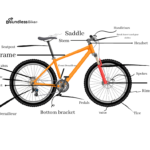Are you in the market for a new bike? One of the most important things to consider is the size of your bike frame. A properly sized frame can make all the difference in your comfort and performance while riding. But how exactly are bike frames measured? And what’s the difference between road bikes and mountain bikes when it comes to sizing? In this blog post, we’ll break down everything you need to know about measuring bike frames so you can find the perfect fit for your next ride.
How are bike frames measured?
Bike frames are measured in a variety of ways, depending on the brand and model. However, the most common measurement is based on the length of the seat tube. This is the vertical part of the frame that holds your bike seat. The length is usually measured from where it meets the bottom bracket to where it meets either the top tube or topmost point of a sloping top tube.
Another important measurement to consider when sizing your bike frame is standover height. This refers to how high you have to lift your leg over the bike’s top tube when standing over it with both feet flat on the ground.
You should also take into account other factors such as reach and stack measurements which can vary greatly between different brands and models.
It’s worth noting that while these measurements offer a good starting point for finding an appropriate bike size, they don’t necessarily account for differences in body proportions or riding style which may cause some riders discomfort even if their bike size seems correct according to these standards. Therefore, trying out bikes before purchasing them is always recommended!
What is the difference between a road bike and a mountain bike frame
When it comes to choosing a bike frame, the type of riding you plan on doing is an important factor to consider. Two popular types of bikes are road bikes and mountain bikes, each with their own unique frame design.
Road bike frames are typically designed for speed and efficiency on smooth pavement. They have a more aerodynamic shape and come in a variety of materials such as aluminum, carbon fiber, and steel. Road bike frames also tend to have thinner tires than mountain bikes.
Mountain bike frames, on the other hand, are built for off-road terrain which means they need to be durable enough to handle rough trails. These frames often have suspension systems that help absorb shock when going over bumps or rocks. Mountain bike frames also usually come in heavier materials like aluminum or steel because durability is key in this type of riding.
One noticeable difference between road bike and mountain bike geometry is the top tube length – where your body sits over the bicycle frame – as well as how upright your posture will be while cycling. While road biking leans towards comfort-oriented endurance rides with longer distances covered at once; off-road riding requires more agility due to bumpy terrains thus making MTBs shorter wheelbases so riders can easily navigate tight turns without sacrificing stability
When selecting a new bicycle frame always take into account what kind of biking you plan on doing before making any decisions since each has its own advantages depending upon individual preferences!
How to measure your own bike frame
Measuring your own bike frame can be a bit tricky, but it’s essential to ensure that you have the right size for your body. The first thing you need to do is find a measuring tape and a friend to help you out.
Start by measuring the length of the seat tube from the center of the bottom bracket to where the seat post enters into it. This measurement gives you an idea of how high or low your saddle will sit in relation to your pedals.
Next, measure the top tube length from where it meets with the head tube at one end and goes all the way back towards its other end. This measurement helps determine how far forward or backward your handlebars will be placed relative to your saddle position.
The third measurement is stand-over height, which determines how much clearance there should be between yourself and your bike’s top bar when straddling over it. To take this measurement accurately, place both feet flat on either side of where that top bar would otherwise intersect with them while standing straight up.
Don’t forget about stack height! Stack height measures vertical distance between BB centerline (bottom bracket)and mid-point line segment connecting headset cups’ upper edges.
This number matters because if too short/long than stem may not fit properly resulting in poor handling/etc!
Taking these measurements might seem intimidating at first glance but once done correctly,sizes become clearer which translates in comfortable rides with fewer injuries as well as better handling for those who love performance-oriented cycling!
Conclusion
Measuring your bike frame correctly is essential for a comfortable and safe ride. Whether you’re looking to buy a new bike or simply want to ensure that your current one fits perfectly, understanding how bikes are measured can save you time and money.
When it comes to road bikes versus mountain bikes, there are some key differences in frame measurement. Road bike frames tend to be measured by their seat tube length, while mountain bikes may be measured by top tube length or standover height. Always check with the manufacturer’s specifications before making any purchases.
Measuring your own bike frame is a simple process that requires only a few basic tools and some careful attention. By following our guide above, you’ll be able to get accurate measurements every time.
So whether you’re buying online or offline always take note of the measurements of the bike frames so as not to end up with an uncomfortable fit during rides. With this knowledge on how frames are measured, we hope riders will now have an easier time finding the perfect fit for their biking needs!
Also Read Do bike frame size matter?






